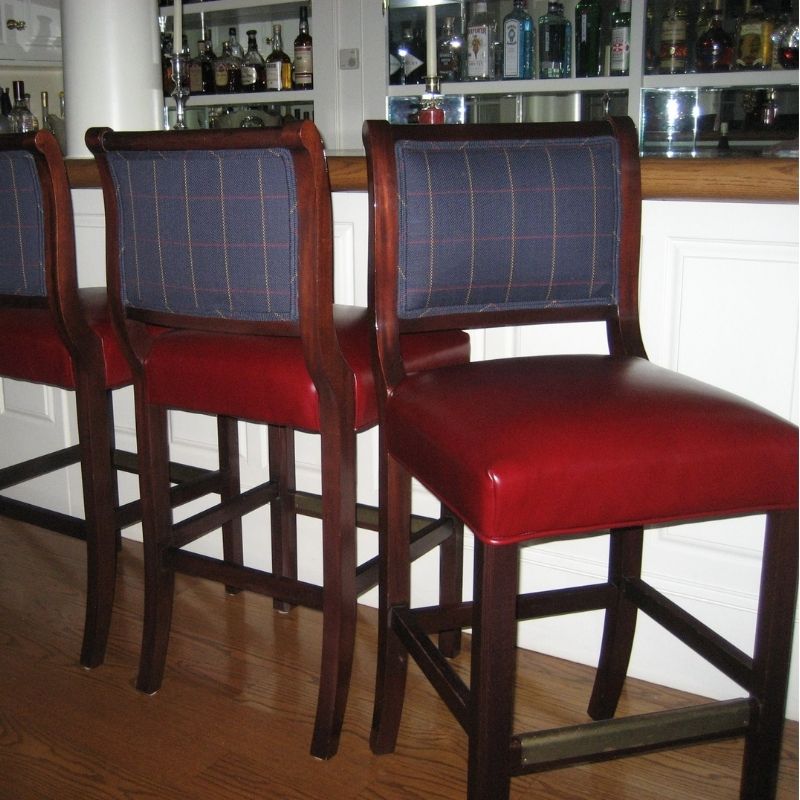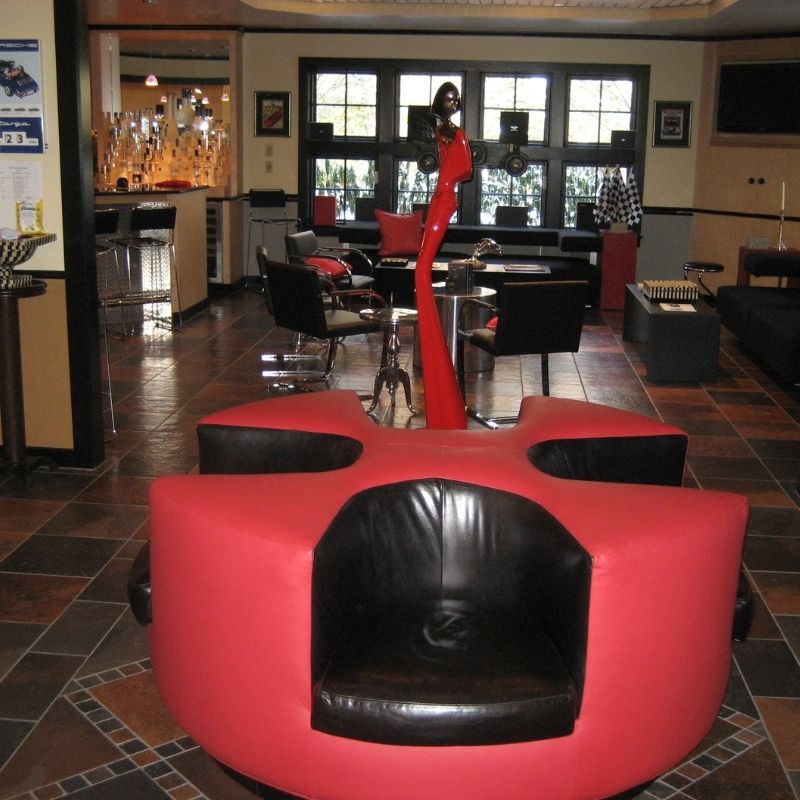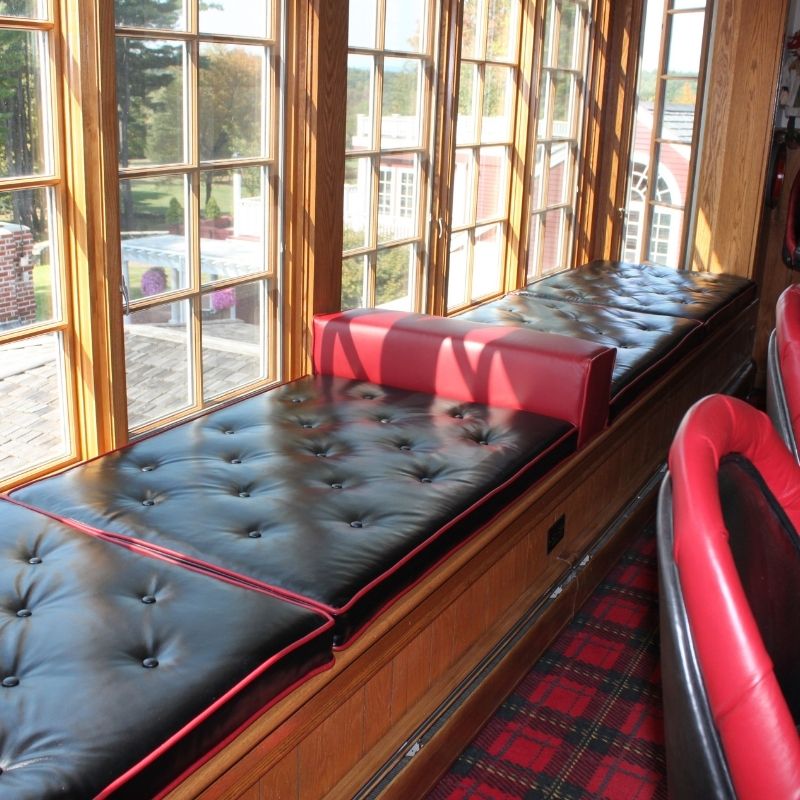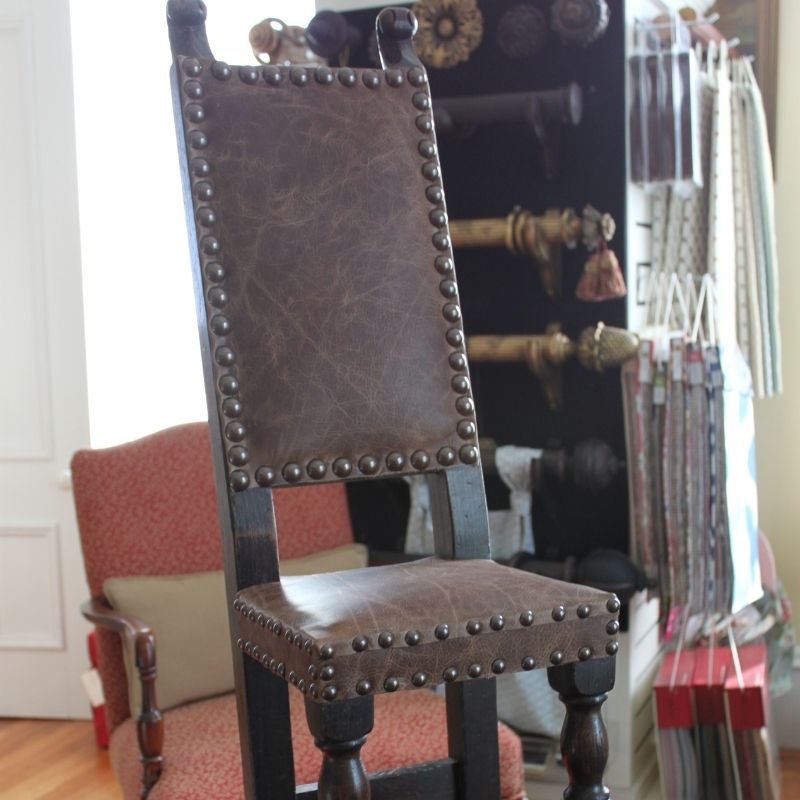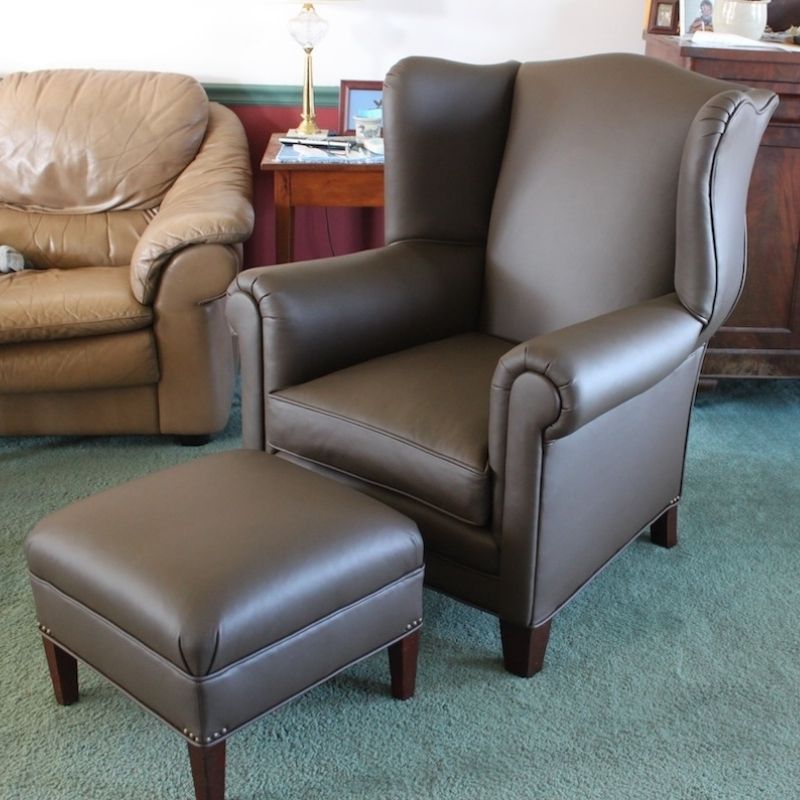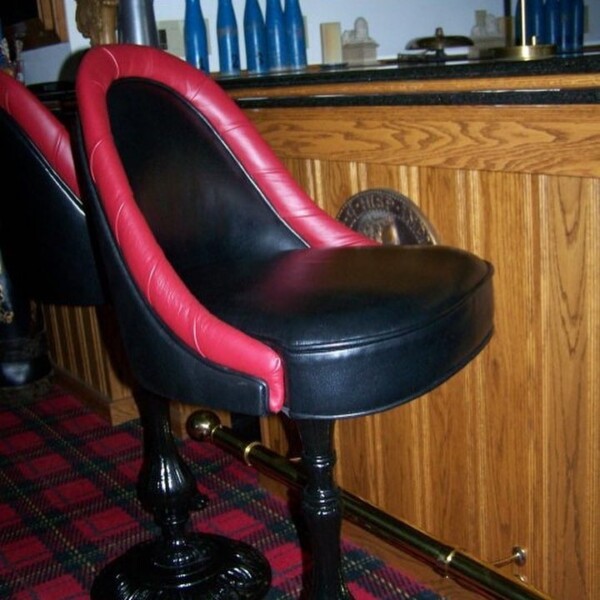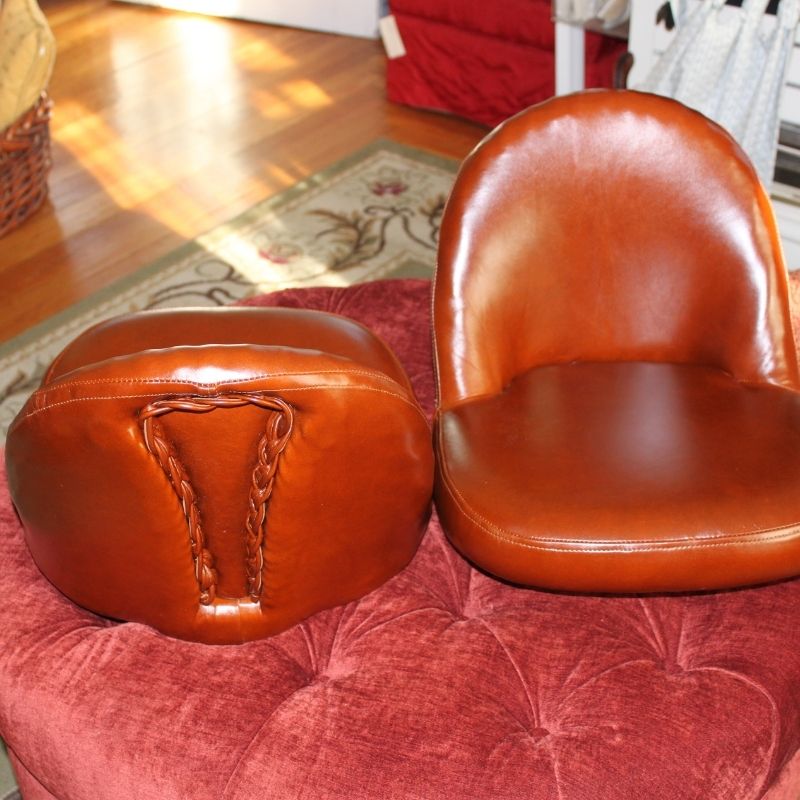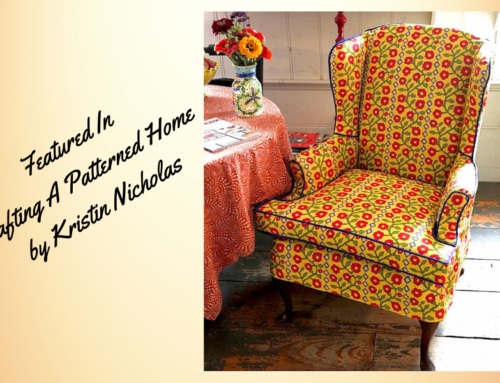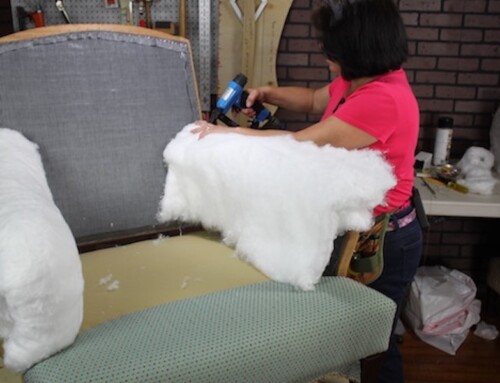Is it hard working with leather upholstery?
Any new skill can feel hard until you’ve learned the hows and whys of the process. The first time I was asked to upholster pieces in leather, I was so scared. The cost of a hide is not inexpensive, and if I made a mistake and had to order another hide, yikes! Luckily, my upholstery skills were excellent, but I was still a nervous wreck.
Different Types Of Leather
- Full Grain
- Top Grain
- Genuine or Corrected
- Bonded
- Faux
You’ll want top-grain upholstery leather weighing 2 – 3 oz for upholstery. Pulling and working with it is more challenging when you get heavier leather. Heavier weights are not conducive to bending around a furniture frame. They are typically used for projects like saddlery, wallets, tools, and belt making. Garment-weight leather is generally less than 2 ounces. You’ll need something thicker and more durable for furniture.
Because a hide is a skin, there are places where it is at an optimal thickness and spots where the leather can be thinner. The flanks, or the edges of the hide, tend to have thinner skin. Avoiding these areas as you’re planning your cutting layout would be best.
Things you’ll need when working with leather for upholstery
Heavy Duty Scissors –
A good pair of heavy-duty Wiss scissors or whatever sharp scissors you may have that can handle the heavier weight of leather. Whatever you use needs to be sharp! My Kai scissors are great, but leather would dull them quickly, so I stay away from those when working with leather.
Needles –
Diamond point, size 18 needles that fit your industrial machine. A diamond point needle looks like an arrowhead. The corners are sharp, and it cuts through the hide. You may be able to sew through leather with a regular upholstery needle on an industrial sewing machine, but you’ll hear a solid thunk as that ballpoint needle pushes through the hide. Diamond or triangle points are preferred for leather and will give you the best results. My personal favorite are the titanium diamond point needles, they are strong and last longer.
Thread –
I use #69 nylon thread in most leather upholstery applications and find it works well. Many industrial machines can accommodate threads as heavy as #90 and #135. These heavier threads are nice for details like decorative topstitching.
Staples or Clips for Seams-
When sewing cushions or joining seams I recommend stapling in the seam allowance to hold seams while stitching. Alternatively, large wonder clips will do the job. Some upholsterers prefer to glue pieces of leather together before stitching (Sailrite also has the glue for that). I prefer to staple. I am always leery of gluing. If you’ve glued the pieces together and need to adjust the glue is not going to be your friend.
Friction sewing leather –
When you sew on leather, the suede back produces friction and drags against the machine bed. A couple of ways to help with this are lightly spraying your sewing machine bed with silicon spray or placing a layer of paper underneath your work. The paper will tear right off when you’re finished sewing.
Sewing machine –
An industrial sewing machine with a walking foot is preferred. These machines have motors strong enough to stitch through multiple heavy layers of leather. The walking foot helps the machine feed the leather through the needle smoothly. Most home machines just won’t be strong enough to handle the thickness of the leather. I have a blog about choosing a suitable sewing machine for upholstery.
TECHNIQUES FOR WORKING WITH LEATHER
Figuring Yardage –
Upholstery leather is sold in hides. You’ll measure a piece of furniture like you usually do and figure yardage just like you figure for fabric. An average hide is about 50 square feet. There are 18 square feet per yard of upholstery fabric. Multiply the yards required by 18 square feet, then divide by 50 square feet for a typical-size hide. [(yards x 18 square feet)/50 = number of hides] This is a BALL PARK guesstimate for the number of hides you’ll need. When in doubt, round up and add one more hide to your order. Roden Leather has a great resource page for upholsterers here and also here.
While the above formula gives you a BALLPARK figure, reviewing your needs with your supplier after taking measurements is a good idea. Leather suppliers almost always have someone who can review your figures and help determine the number of hides you need.
Remember, a leather hide is shaped like the animal it came from. There will be edges you cannot use and a fair amount of waste. You’ll have to plan for cutting around scars, insect bites, and imperfections on the skin. You’ll want to carefully plan a cutting guide for using your hides most efficiently. As you work, save the scraps! They’ll be great for practicing your leather sewing skills, as well as for a variety of other fun projects. Roden Leather has an excellent resource for estimating yardage into square feet for hides. The handy PDF is downloadable, too.
Stitches –
When sewing leather, increase your stitch length to 6 or 7. If your stitches are too small, your seam may perforate the leather and cause it to tear away. Sew on some scraps to determine your optimal stitch length.
Seam Allowance –
I generally upholster with a standard seam allowance of ½”. With leather, you may want to reduce that seam allowance to ¼”. The larger seam allowance can look bulky when working with leather, and since leather doesn’t fray, we can get by with a smaller seam allowance. For cushions, I generally stick with my standard ½” seam allowance.
The Pull –
We had many discussions in our community on Wednesday, Q and As, about learning the art of the pull! Once you master pulling upholstery fabric evenly and smoothly and successfully managing pleats and folds without puckers, you’ll be ready to do the same with leather. Leather stretches a bit easier, and you’ll have to pull harder. If you struggle with hand strength, a technique that may help is to pull hard and put in a temporary staple. Let the leather rest, then return later and pull again before setting permanent staples. It’s a slower process than what you’d use for fabric, but it gives satisfactory results. Think of how a great pair of leather shoes stretch over time. Leather does the same thing on an upholstered piece in areas like the seat, cushions, and inside backs. So getting it TIGHT is key.
Hair On Hides –
Hair on hide adds a bit of fun and looks great on upholstery pieces in Western and rustic decor! If you choose hair on hide, know that it is generally thicker than hairless leather. The thickness makes it difficult to stretch around the frame, and making corners with it is not ideal. When you plan for placement, you’ll want to pay attention to natural markings, cowlicks, or parts in the hair. Choose carefully your “right” piece of furniture for hair on hide.
Skiving –
Skiving is a technique where, using a specialized tool, you shave down the thickness of the leather to reduce bulk. You generally won’t need to skive leather applied to your furniture frame, but depending on the thickness of your leather, you may want to skive the ends of your cording strip joins to reduce bulk in your leather cording.
RESOURCES FOR BUYING LEATHER
You’ll find by contacting any of these suppliers that they can be enormously helpful in choosing a leather product for your project. You can find hides on eBay and Etsy, but the old maxim “buyer beware” applies. I’ve seen leather hides that were too thin or too thick and stiff and others that had been folded and had permanent creases. Folding a hide should be avoided.
From the Roden Leather website
Genuine leather requires very little care. Dust it regularly, and minor spots can be washed off. Use lukewarm water and mild soap, but nothing abrasive. Work up some suds and go over the surface with a soft cloth. Rinse off any soap film with clean water and toweling. It may dry dull, but normal gloss can be restored by rubbing with clean toweling. These instructions apply to finished leather only, not to any suede. Never use furniture polish, oil, varnish, ammonia, or cleaning solvents. Our leather hides for upholstery will last a lifetime if cared for properly.
This product is made from shredded leather scraps and fibers, creating a pulp that is much like paper pulp. The pulp is bound with polyurethane and adhered to a fiber or fabric backing. After processing, it is colored, printed, and coated. Similarly, recycled leather is made from leather scraps ground to dust and mixed with natural rubber. After processing, it’s colored, printed, and coated. In the US, bonded leather and recycled leather are required to only have 10 – 20% leather. The life of these products is 3 – 5 years. Most of us want our upholstery work to last much longer than that! If you have a piece of leather furniture where the leather is peeling away from a backing, it’s likely bonded or recycled leather. Bonded and recycled leather do contain leather, but if you’re looking for durability, choose top-grain leather.
“leather fabric” or “leather look fabric” are marketed by fabric retailers as an alternative to leather. These products do not contain leather. They are often vinyl. There is undoubtedly a place for vinyl in upholstery! Faux leather or vinyl products may be just what you’re looking for. Vinyls are a topic for a different blog!
Well, are you ready to take the plunge and try your hand at working with leather on your upholstery project?
I’d love to see what you do and hear how the process went. If you have any questions and are a member, post in the community forum and ask away. We have a private Facebook group for those who are not your members. Join Kim’s DIY Upholstery Hangout and tell us what you’re working on. (if you’re ready to dive into the membership, use the link below to receive a special discount when you join today as a thank you for reading our blog)
One benefit of our Kim’s Upholstery Membership is the live chats on Wednesdays at 3:00 PM Eastern time. If you’re unavailable on Wednesdays at 3, these chats are archived in the membership, and you can log in and watch them anytime. During the Q&A, members bring their questions on any upholstery topics, current projects, and areas where they need help. Recently, there have been a lot of questions about leather.
While I don’t recommend leather as a beginner project, once you’ve built your upholstery skill set and successfully upholstered several pieces in upholstery-weight fabric, you’ll find that you can successfully transition those skills to leather.
Through the membership, you’ll learn how to upholster furniture using a variety of appropriate materials, such as leather. Leather uses the same techniques, and the good thing is that there is no grain to follow, so you can run it in any direction, and it stretches nicely in all directions.
You can do it!


